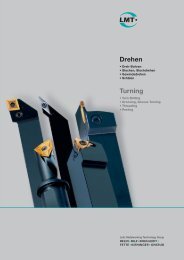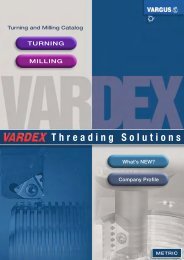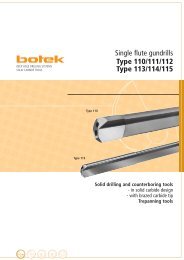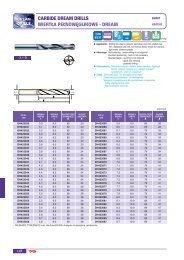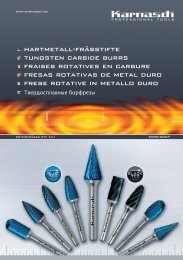Gear Cutting Tools
Hobs - Torion
Hobs - Torion
- No tags were found...
Create successful ePaper yourself
Turn your PDF publications into a flip-book with our unique Google optimized e-Paper software.
Calculation of the root<br />
form circle diameter<br />
The root form circle diameter can<br />
be calculated using the software<br />
developed by FETTE.<br />
In theory, the root curve comprises<br />
the region generated by the tooth<br />
tip radius and that profiled by the<br />
protuberance flank. The second<br />
region is an involute profile, in<br />
which the involute intersects the<br />
root curve of the main involute.<br />
The intersection is determined by<br />
the root form circle diameter. In the<br />
majority of cases examined, the involute<br />
region of the undercut curve<br />
is not present, however, and the<br />
root rounding generated by the<br />
tooth tip radius forms the intersection<br />
with the main involute.<br />
If the root form circle diameter or the effective root circle diameter are not<br />
specified in the workpiece drawing, the effective root circle diameter<br />
must be calculated from the gear pair data according to the following formulae:<br />
(1) d Nf1 = (2 · a · sin α wt – d 2 Na2 – d 2 b2) 2 + d 2 b1<br />
(2) d Nf2 = (2 · a · sin α wt – d 2 Na1 – d 2 b1) 2 + d 2 b2<br />
(3) cos α wt = (z 1 + z 2 ) · m t · cos αt<br />
2 · a<br />
(4) m t =<br />
m n<br />
cos β<br />
(5) tan α t = tan α n<br />
cos β<br />
(6) d b = z · m n · cos α t<br />
cos β<br />
Calculation of the effective root circle diameter<br />
It has proved practical to plot the<br />
computed root curve and to analyse<br />
the result of the plot. The<br />
intersection of the root curve with<br />
the main involute following machining<br />
is of decisive importance<br />
for evaluation of the root form circle<br />
diameter. On gears which have<br />
been hardened and ground, it<br />
must be considered that hardening<br />
distortion and incorrect centring of<br />
the grinding disk result in different<br />
volumes being ground off the<br />
roughed tooth flank. This may result<br />
in the root form circle diameter<br />
being displaced from the theoretical<br />
dimension arrived at by calculation.<br />
In such cases, it must be<br />
ensured that an adequate reserve<br />
remains between the calculated<br />
root form circle diameter and the<br />
requisite root form circle diameter.<br />
Practical experience has shown<br />
that gears with a small number of<br />
teeth and only a small positive profile<br />
displacement may lead to<br />
problems if the root form circle diameter<br />
is too large. The result can<br />
be improved by a smaller protuberance<br />
quantity, a larger addendum,<br />
or a smaller tooth tip radius<br />
on the basic hob profile.<br />
In formulae (1) and (2), either the<br />
tip circle diameter, or if a chamfer<br />
is present, the tip form circle diameter<br />
of the corresponding mating<br />
gears, are employed as the effective<br />
tip circle diameter.<br />
Where:<br />
d Nf1 , d Nf2 = effective root circle diameter<br />
d Na1 , d Na2 = effective tip circle diameter<br />
a = centre distance<br />
α wt = operating pressure<br />
angle<br />
d b = base diameter<br />
z 1 , z 2 = number of teeth<br />
m t = real module<br />
α t = real pressure angle<br />
β = helix angle<br />
machining<br />
allowance<br />
root form circle on<br />
the gear following<br />
machining<br />
root form circle on<br />
the finished gear<br />
Tooth gap profile in the face plane<br />
181



